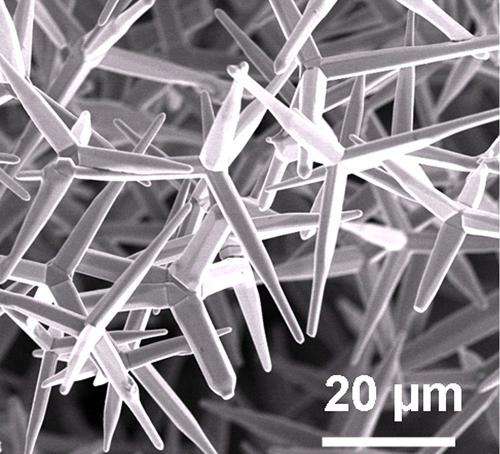Predicting fatigue: Nanocrystals reveal damaged material

A small crack in a metal wheel caused Germany's worst-ever rail accident—the 1998 Eschede train disaster. The problem: it was practically impossible to detect damage of that nature to a metal by inspecting it externally. But now scientists have succeeded in making material fatigue visible. They designed new synthetic materials that emit light to report high mechanical stress.
The scientists of Kiel University, University of Erlangen-Nuremberg and the Technische Universität München (TUM) have published their results in the current issue of the journal Advanced Materials.
"The luminescent features of zinc oxide tetrapod crystals are well established. According to our work hypothesis, these characteristics showed pronounced variations under a mechanical load, and we realised that it could help to detect internal damages of composite materials", says Dr. Yogendra Mishra of Kiel University's Technical Faculty. In one experiment, the scientists added zinc oxide tetrapod shaped crystals to a silicone (polydimethylsiloxane) polymer and tested its general properties. They found that the resulting composite material is on the one hand stronger than silicon and on the other hand emits light in different colors when exposed to UV light. When the material is subjected to mechanical stress, the intensities of the emitted lights changes.

"The micro-nano sized crystals give a visual warning when the composite material is about to fail under stress", explains PhD student Xin Jin. "The alteration of the luminescent characteristics of defined semiconductor microstructures under load – as we could show for zinc oxide tetrapods – might be also interesting of many other phosphor material systems", adds Professor Cordt Zollfrank who leads the research area 'biogeneous polymers' at TUM. "We expect further interesting developments in this emerging field on "self-reporting materials".
Composite polymer materials are used in diverse fields from dental implants to spacecrafts. They are made from two or more constituent materials with different properties such as silicone and zinc oxide crystals which together render better properties. On demands, they can be designed to be light-weight, mechanically robust and still inexpensive. Professor Rainer Adelung, leader of the study, says: "Zinc oxide crystals seem to be an excellent component to design numerous specific composite materials – also for constructions in which stability is critical to life."
More information: Xin Jin, Michael Götz, Sebastian Wille, Yogendra Kumar Mishra, Rainer Adelung, Cordt Zollfrank (2012): A novel concept for self-reporting materials: Stress sensitive photoluminescence in ZnO tetrapod filled elastomers, Advanced Materials, doi: adma.201203849
Journal information: Advanced Materials
Provided by Technical University Munich



















